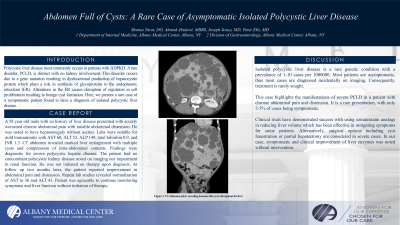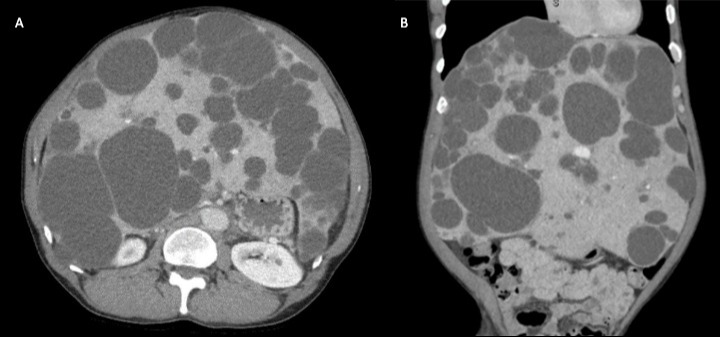Sunday Poster Session
Category: Liver
P1360 - Abdomen Full of Cysts: A Rare Case of Asymptomatic Isolated Polycystic Liver Disease
Sunday, October 27, 2024
3:30 PM - 7:00 PM ET
Location: Exhibit Hall E

Has Audio
- ST
Shunsa Tarar, DO
Albany Medical Center
Albany, NY
Presenting Author(s)
Shunsa Tarar, DO1, Ahmad Abulawi, MD2, Joseph Soucy, MD1, Seth Richter, MD1
1Albany Medical Center, Albany, NY; 2Albany Medical College, Albany, NY
Introduction: Polycystic liver disease most commonly occurs in patients with autosomal dominant polycystic kidney disease (ADPKD). A rare disorder, autosomal dominant polycystic liver disease (PCLD), is distinct with no kidney involvement. This disorder occurs due to a gene mutation resulting in dysfunctional production of hepatocystin protein which plays a role in synthesis of glycoproteins in the endoplasmic reticulum (ER). Alterations in the ER causes disruption of regulators in cell proliferation resulting in benign cyst formation. Here, we present a rare case of a symptomatic patient found to have a diagnosis of isolated polycystic liver disease.
Case Description/Methods: A 58 year old male with no history of liver disease presented with acutely worsened chronic abdominal pain with notable abdominal distension. Upon evaluation, he was noted to have hepatomegaly without ascites. Labs were notable for mild transaminitis with AST 60, ALT 52, alkaline phosphatase 149, total bilirubin 0.9, and INR 1.3. CT abdomen revealed marked liver enlargement with multiple cysts and compression of intra-abdominal contents. Findings were diagnostic for severe polycystic hepatic disease resulting in compression of abdominal organs. The patient had no concomitant polycystic kidney disease noted on imaging nor impairment in renal function. He was not initiated on therapy upon diagnosis and was monitored for symptoms. At follow up two months later, the patient reported improvement in abdominal pain and distension. Repeat lab studies revealed normalization of AST to 36 and ALT 43. Patient was agreeable to continue monitoring symptoms and liver function without initiation of therapy.
Discussion: Isolated polycystic liver disease is a rare genetic condition with a prevalence of 1-10 cases per 1000000. Most patients are asymptomatic, thus most cases are diagnosed incidentally on imaging. Consequently, treatment is rarely sought.
This case highlights the manifestations of severe PCLD in a patient with chronic abdominal pain and distension. It is a rare presentation, with only 2-5% of cases being symptomatic.
Clinical trials have demonstrated success with using somatostatin analogs in reducing liver volume which has been effective in mitigating symptoms for some patients. Alternatively, surgical options including cyst fenestration or partial hepatectomy are considered in severe cases. In our case, symptomatic and clinical improvement of liver enzymes was noted without intervention.

Disclosures:
Shunsa Tarar, DO1, Ahmad Abulawi, MD2, Joseph Soucy, MD1, Seth Richter, MD1. P1360 - Abdomen Full of Cysts: A Rare Case of Asymptomatic Isolated Polycystic Liver Disease, ACG 2024 Annual Scientific Meeting Abstracts. Philadelphia, PA: American College of Gastroenterology.
1Albany Medical Center, Albany, NY; 2Albany Medical College, Albany, NY
Introduction: Polycystic liver disease most commonly occurs in patients with autosomal dominant polycystic kidney disease (ADPKD). A rare disorder, autosomal dominant polycystic liver disease (PCLD), is distinct with no kidney involvement. This disorder occurs due to a gene mutation resulting in dysfunctional production of hepatocystin protein which plays a role in synthesis of glycoproteins in the endoplasmic reticulum (ER). Alterations in the ER causes disruption of regulators in cell proliferation resulting in benign cyst formation. Here, we present a rare case of a symptomatic patient found to have a diagnosis of isolated polycystic liver disease.
Case Description/Methods: A 58 year old male with no history of liver disease presented with acutely worsened chronic abdominal pain with notable abdominal distension. Upon evaluation, he was noted to have hepatomegaly without ascites. Labs were notable for mild transaminitis with AST 60, ALT 52, alkaline phosphatase 149, total bilirubin 0.9, and INR 1.3. CT abdomen revealed marked liver enlargement with multiple cysts and compression of intra-abdominal contents. Findings were diagnostic for severe polycystic hepatic disease resulting in compression of abdominal organs. The patient had no concomitant polycystic kidney disease noted on imaging nor impairment in renal function. He was not initiated on therapy upon diagnosis and was monitored for symptoms. At follow up two months later, the patient reported improvement in abdominal pain and distension. Repeat lab studies revealed normalization of AST to 36 and ALT 43. Patient was agreeable to continue monitoring symptoms and liver function without initiation of therapy.
Discussion: Isolated polycystic liver disease is a rare genetic condition with a prevalence of 1-10 cases per 1000000. Most patients are asymptomatic, thus most cases are diagnosed incidentally on imaging. Consequently, treatment is rarely sought.
This case highlights the manifestations of severe PCLD in a patient with chronic abdominal pain and distension. It is a rare presentation, with only 2-5% of cases being symptomatic.
Clinical trials have demonstrated success with using somatostatin analogs in reducing liver volume which has been effective in mitigating symptoms for some patients. Alternatively, surgical options including cyst fenestration or partial hepatectomy are considered in severe cases. In our case, symptomatic and clinical improvement of liver enzymes was noted without intervention.

Figure: Figure 1. CT abdomen pelvis revealing innumerable cysts throughout the liver resulting in compression of intra-abdominal contents without corresponding kidney cysts (A and B).
Disclosures:
Shunsa Tarar indicated no relevant financial relationships.
Ahmad Abulawi indicated no relevant financial relationships.
Joseph Soucy indicated no relevant financial relationships.
Seth Richter indicated no relevant financial relationships.
Shunsa Tarar, DO1, Ahmad Abulawi, MD2, Joseph Soucy, MD1, Seth Richter, MD1. P1360 - Abdomen Full of Cysts: A Rare Case of Asymptomatic Isolated Polycystic Liver Disease, ACG 2024 Annual Scientific Meeting Abstracts. Philadelphia, PA: American College of Gastroenterology.
